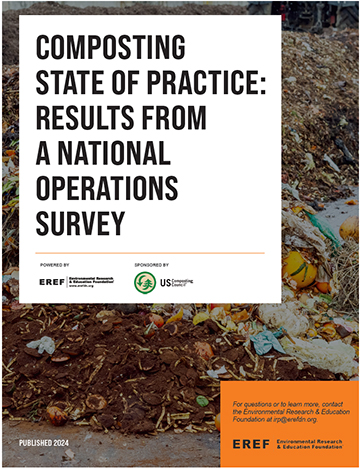 Compost production is growing in the U.S. as regulations in some parts of the country aim to keep organics out of landfills according to a new report from the Environmental Research & Education Foundation (EREF), Raleigh, North Carolina. The report, Composting State of Practice: Results from a National Operations Survey, which was conducted in collaboration with the U.S. Composting Council, Raleigh, and the Desert Research Institute, Reno, Nevada, is based on responses from more than 300 composting facilities to a questionnaire send in 2022.
Compost production is growing in the U.S. as regulations in some parts of the country aim to keep organics out of landfills according to a new report from the Environmental Research & Education Foundation (EREF), Raleigh, North Carolina. The report, Composting State of Practice: Results from a National Operations Survey, which was conducted in collaboration with the U.S. Composting Council, Raleigh, and the Desert Research Institute, Reno, Nevada, is based on responses from more than 300 composting facilities to a questionnaire send in 2022.
Key findings of the report included:
- Growth in the composting sector. The tonnage of organics processed and the number of active composting facilities have both increased in 2019 and 2021 compared to 2016 levels;
- Regional differences in facility characteristics. The Northeast has many facilities with small or micro design capacities while the Southeast and Pacific regions have fewer but larger capacity facilities, leading in tons processed;
- Windrows are the most common composting method. Forty-two percent of facilities used windrows, however, more than 20% of the surveyed facilities use multiple composting methods. These facilities are responsible for processing more organic waste and producing more compost compared to single-method facilities;
- Operational concerns. Issues that affect day-to-day operations, such as physical contamination and labor, are considered important by the majority of respondents. In contrast, less visible issues like microplastics and chemical contamination are deemed less important, although they may become more significant as new regulations emerge;
- Revenue sources and facility size. The report highlights differences in revenue sources based on region and facility size. For example, the Pacific and Southeast regions rely heavily on tipping fees, while the Midwest sees a higher percentage of revenue from product sales.
EREF said the report aims to inform and guide stakeholders, decision makers and environmental advocates toward more effective and innovative composting strategies by providing a detailed snapshot of the composting industry’s current state. Survey respondents ranged from small, educational community compost sites to highly technical sites processing several tons of organics a day.
Despite having about half the number of facilities represented as the Northeast, the Pacific and the Southeast regions managed about 40% and 30% of organics in 2021, respectively. In comparison, the Northeast had the greatest number of facilities reporting, but processed just under 10% of organics in 2021.
Windrows were the most common composting method with 42% of facilities reporting using that method. Twenty-two percent of facilities use multiple composting methods—the second most commonly reported method and the method responsible for processing more organic waste and producing more compost than any of the single-method facilities.
Facilities also reported on the types of feedstocks that they accept with about a third of facilities only accepting a single feedstock. Yard waste was the most commonly accepted feedstock with just under 80% of facilities accepting this feedstock. Food waste was second, with 51% of facilities accepting food waste. Sixty percent of facilities reported that these feedstocks are collected from 25 miles away or less.
Responses indicated that large facilities rely on tipping fees for 80% of their revenue, on average, while smaller facilities generate more revenue from product sales and “other” revenue streams. About a third of the compost produced by respondents is sold for agricultural purposes, while landscaping was the most common market for a producer to sell to with 68% of facilities selling to this market.
The report was mainly funded by Mars Advanced Research Institute, McLean, Virginia and Chick-fil-A, Atlanta.
The report can be downloaded here.
Follow us on social media:


Be the first to comment on "Compost production is growing, report says"